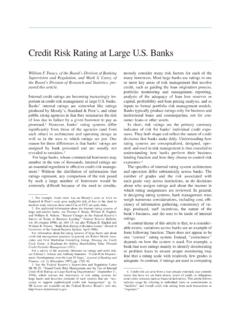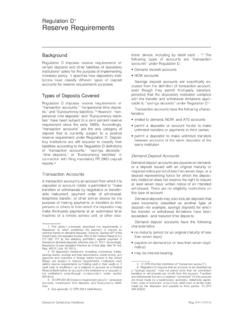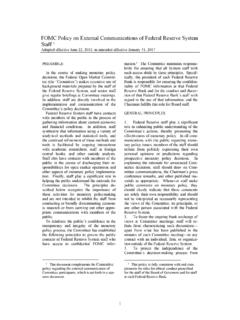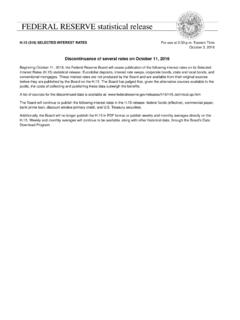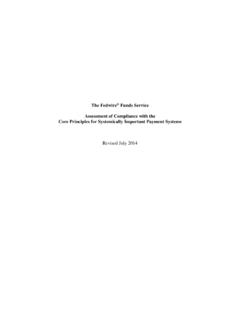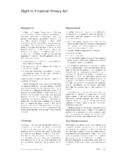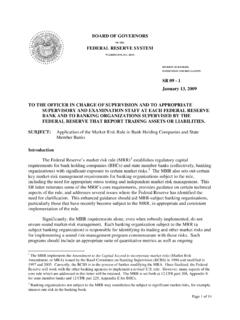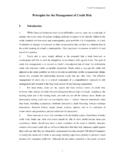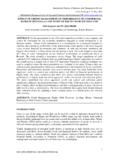Transcription of Office of the Comptroller of the Currency Board of ...
1 Office of the Comptroller of the Currency Board of Governors of the Federal Reserve System Federal Deposit Insurance Corporation Concentrations in Commercial Real Estate Lending, Sound Risk management Practices (December 12, 2006) Page 1 of 8 PURPOSE The Office of the Comptroller of the Currency , the Board of Governors of the Federal Reserve System, and the Federal Deposit Insurance Corporation (collectively, the Agencies), are jointly issuing this Guidance to address institutions increased concentrations of commercial real estate (CRE) loans. Concentrations of credit exposures add a dimension of risk that compounds the risk inherent in individual loans. The Guidance reminds institutions that strong risk management practices and appropriate levels of capital are important elements of a sound CRE lending program, particularly when an institution has a concentration in CRE loans.
2 The Guidance reinforces and enhances the Agencies existing regulations and guidelines for real estate lending [Footnote 1 - Refer to the Agencies regulations on real estate lending standards and the Interagency Guidelines for Real Estate Lending Policies: 12 CFR part 34, subpart D and appendix A (OCC); 12 CFR part 208, subpart E and appendix C (FRB); and 12 CFR part 365 and appendix A (FDIC). Refer to the Interagency Guidelines Establishing Standards for Safety and Soundness: 12 CFR part 30, appendix A (OCC); 12 CFR part 208, Appendix D-1 (FRB); and 12 CFR part 364, appendix A (FDIC). End of Footnote 1] and loan portfolio management in light of material changes in institutions lending activities. The Guidance does not establish specific CRE lending limits; rather, it promotes sound risk management practices and appropriate levels of capital that will enable institutions to continue to pursue CRE lending in a safe and sound manner.
3 BACKGROUND The Agencies recognize that regulated financial institutions play a vital role in providing credit for business and real estate development. However, concentrations in CRE lending coupled with weak loan underwriting and depressed CRE markets have contributed to significant credit losses in the past. While underwriting standards are generally stronger than during previous CRE cycles, the Agencies have observed an increasing trend in the number of institutions with concentrations in CRE loans. These concentrations may make such institutions more vulnerable to cyclical CRE markets. Moreover, the Agencies have observed that some institutions risk management practices are not evolving with their increasing CRE concentrations. Therefore, institutions with concentrations in CRE loans are reminded that their risk management practices and capital levels should be commensurate with the level and nature of their CRE concentration risk.
4 Page 2 of 8 SCOPE In developing this guidance, the Agencies recognized that different types of CRE lending present different levels of risk, and that consideration should be given to the lower risk profiles and historically superior performance of certain types of CRE, such as well-structured multifamily housing finance, when compared to others, such as speculative Office space construction. As discussed under CRE Concentration Assessments, institutions are encouraged to segment their CRE portfolios to acknowledge these distinctions for risk management purposes. This Guidance focuses on those CRE loans for which the cash flow from the real estate is the primary source of repayment rather than loans to a borrower for which real estate collateral is taken as a secondary source of repayment or through an abundance of caution.
5 Thus, for the purposes of this Guidance, CRE loans include those loans with risk profiles sensitive to the condition of the general CRE market (for example, market demand, changes in capitalization rates, vacancy rates, or rents). CRE loans are land development and construction loans (including 1- to 4-family residential and commercial construction loans) and other land loans. CRE loans also include loans secured by multifamily property, and nonfarm nonresidential property where the primary source of repayment is derived from rental income associated with the property (that is, loans for which 50 percent or more of the source of repayment comes from third party, nonaffiliated, rental income) or the proceeds of the sale, refinancing, or permanent financing of the property. Loans to real estate investment trusts (REITs) and unsecured loans to developers also should be considered CRE loans for purposes of this Guidance if their performance is closely linked to performance of the CRE markets.
6 Excluded from the scope of this Guidance are loans secured by nonfarm nonresidential properties where the primary source of repayment is the cash flow from the ongoing operations and activities conducted by the party, or affiliate of the party, who owns the property. Although the Guidance does not define a CRE concentration, the Supervisory Oversight section describes the criteria that the Agencies will use as high-level indicators to identify institutions potentially exposed to CRE concentration risk. CRE CONCENTRATION ASSESSMENTS Institutions actively involved in CRE lending should perform ongoing risk assessments to identify CRE concentrations. The risk assessment should identify potential concentrations by stratifying the CRE portfolio into segments that have common risk characteristics or sensitivities to economic, financial or business developments.
7 An institution s CRE portfolio stratification should be reasonable and supportable. The CRE portfolio should not be divided into multiple segments simply to avoid the appearance of concentration risk. The Agencies recognize that risk characteristics vary among CRE loans secured by different property types. A manageable level of CRE concentration risk will vary by institution depending on the portfolio risk characteristics, the quality of risk management processes, and capital levels. Therefore, the Guidance does not establish a CRE concentration limit that applies to all institutions. Rather, the Guidance encourages institutions to identify and monitor credit Page 3 of 8 concentrations, establish internal concentration limits, and report all concentrations to management and the Board of directors on a periodic basis.
8 Depending on the results of the risk assessment, the institution may need to enhance its risk management systems. RISK management The sophistication of an institution s CRE risk management processes should be appropriate to the size of the portfolio , as well as the level and nature of concentrations and the associated risk to the institution. Institutions should address the following key elements in establishing a risk management framework that effectively identifies, monitors, and controls CRE concentration risk: Board and management oversight portfolio management management information systems Market analysis Credit underwriting standards portfolio stress testing and sensitivity analysis Credit risk review function Board and management Oversight An institution s Board of directors has ultimate responsibility for the level of risk assumed by the institution.
9 If the institution has significant CRE concentration risk, its strategic plan should address the rationale for its CRE levels in relation to its overall growth objectives, financial targets, and capital plan. In addition, the Agencies real estate lending regulations require that each institution adopt and maintain a written policy that establishes appropriate limits and standards for all extensions of credit that are secured by liens on or interests in real estate, including CRE loans. Therefore, the Board of directors or a designated committee thereof should: Establish policy guidelines and approve an overall CRE lending strategy regarding the level and nature of CRE exposures acceptable to the institution, including any specific commitments to particular borrowers or property types, such as multifamily housing.
10 Ensure that management implements procedures and controls to effectively adhere to and monitor compliance with the institution s lending policies and strategies. Review information that identifies and quantifies the nature and level of risk presented by CRE concentrations, including reports that describe changes in CRE market conditions in which the institution lends. Periodically review and approve CRE risk exposure limits and appropriate sublimits (for example, by nature of concentration) to conform to any changes in the institution s strategies and to respond to changes in market conditions. Page 4 of 8 portfolio management Institutions with CRE concentrations should manage not only the risk of individual loans but also portfolio risk. Even when individual CRE loans are prudently underwritten, concentrations of loans that are similarly affected by cyclical changes in the CRE market can expose an institution to an unacceptable level of risk if not properly managed.
